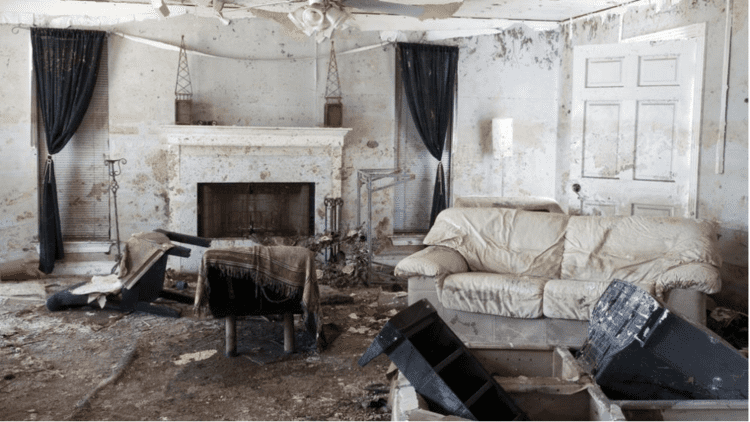
In the aftermath of a flood, it’s easy to be overwhelmed by the scale of the damage to your property and belongings. As the waters subside, the devastation wrought by floodwater becomes apparent. Returning home can be extremely upsetting and physically challenging. Here are a few practical steps you can take to make this trying situation a little easier to manage.
Safety first
Check for structural damage before you try to enter your home. Look out for warping and cracking in structural elements and foundations, and contact the utility company if you have any reason to suspect gas, water, electricity or sewer lines have been compromised. If you have any concerns, seek guidance from utility providers and your local government.
Even if the power is out, check your fuse box and turn off the main switch. Water conducts electricity, and the last thing you want is the power coming back while you're up to your knees in floodwater. Don’t use any electrical equipment, including pumps or dehumidifiers, until you're sure it’s safe to do so.
Be careful that your skin doesn’t come into contact with floodwater. Even if it looks clear, it could be contaminated by household chemicals, sewage or animal waste. Cover as much of your body with waterproof clothing as possible. And cover any cuts or abrasions with waterproof dressings.
Cleaning and drying
If possible, clear wet mud from the floors, walls and furnishings before it has a chance to dry. Once the surfaces have been cleared, use a garden hose to douse the walls in fresh water. Don’t use a high-pressure washer as this could cause damage or result in droplets of tainted water becoming airborne. Start at the ceiling and work your way down. While cleaning, be sure to protect yourself from any bacteria that may be in the water by wearing long sleeves, pants, boots, gloves and eye protection.
Take care when removing water from your property. Buckets of water are very heavy and the ground could be treacherous. Open the windows to allow water to escape, unless doing so would let more water seep into your property.
If you have electricity, be sure an electrician has determined it’s safe to turn it on. If using a pump to clear water from your basement, only remove around a third of the water each day or you could cause structural damage.
If you don't have electricity or it’s not safe to turn on, you can use a portable generator to power equipment for removing standing water. But remember not to operate a gasoline-powered pump inside a home, a basement or another enclosed or partially closed structure, or less than 20 feet from a door, window or vent. Doing so could create dangerous carbon monoxide levels.
Wooden furniture should be left to dry outside if the weather permits, but try not to place items in direct sunlight. If you can’t place items outside, open windows to improve ventilation. Consider using a dehumidifier to speed up the process. Remove all drawers and furniture parts that can be easily disassembled before leaving them to dry. If you can, remove the back or side panels to allow air to circulate.
Some soft furnishings may not be salvageable, but don’t throw anything out until you have spoken with your insurance company or a restoration specialist. Technological advancements have greatly improved the ability to restore water-damaged furniture.
Many electrical appliances, such as freezers, refrigerators and stoves, can be cleaned and dried out, as long as they were not submerged while operational. However, do not attempt to dry them out by yourself and then turn them on without getting them checked by a professional. Wait until an expert has inspected heating and HVAC devices. Turning them on too early could risk an electric short or spread mold spores throughout your property. Diluted chlorine bleach and pine oil cleaners will help control odors and reduce the spread of mold.
You’ll need to dispose of any food that has been in contact with floodwater, unless it's been stored in a vacuum package or a can. Thoroughly clean and sterilize all utensils and food preparation equipment before using them. Boil drinking water and water used for food preparation until the authorities have given the all-clear.
Tips to take back control
It’s very likely that you'll have suffered a significant financial loss as a result of the flood. If you're insured, photograph everything for your insurance company before you start your cleanup. The more supporting evidence you have, the better. Try to locate receipts and important documents and move them to safety.
Follow these practical tips to take back control, and set out on the road to recovery.
- Contact your insurance professional or company representative as soon as you can.
- Secure your property against theft and further damage.
- Check any vehicles for damage.
- Inventory your losses with photographs, receipts and documentation.
- Make a list of any perishable items, such as food, that you had to throw out.
- Be wary of disreputable contractors. Ask your insurance company for a list of approved companies. And don’t sign any repair contracts until you have cleared the work with your insurer.
- Check your insurance coverage carefully and prepare accordingly.
Remember, groundwater flood damage is often excluded from standard homeowner's policies. You may need to confirm the cause of the flood to determine whether you're covered.
Your Rathbun Insurance account manager can provide you with support and information to help you on the road to recovery. Time is of the essence. The faster you get the ball rolling on a claim, the sooner you can return to some sense of normality.
